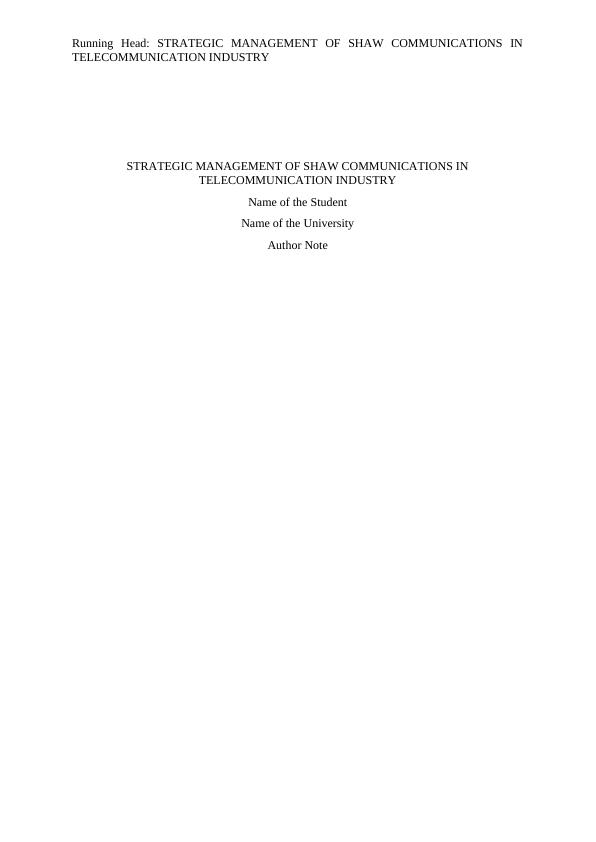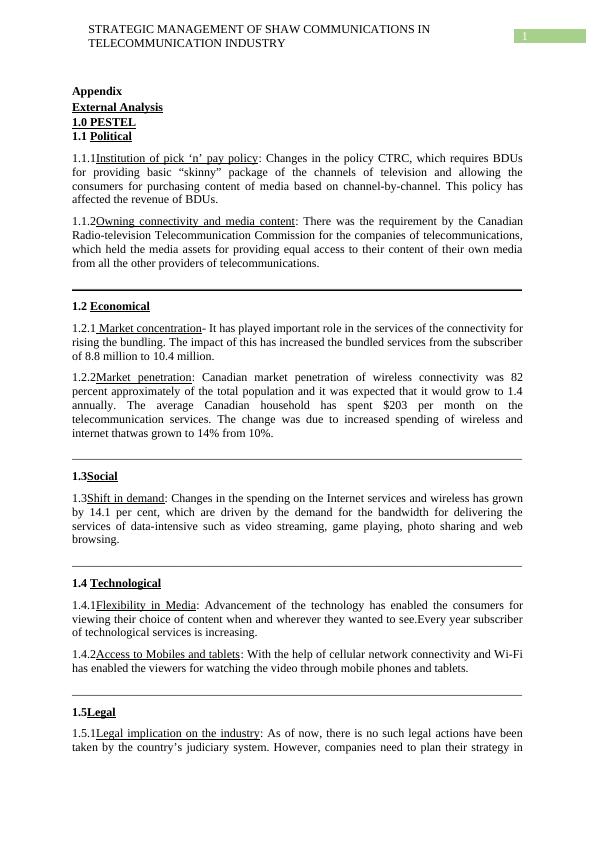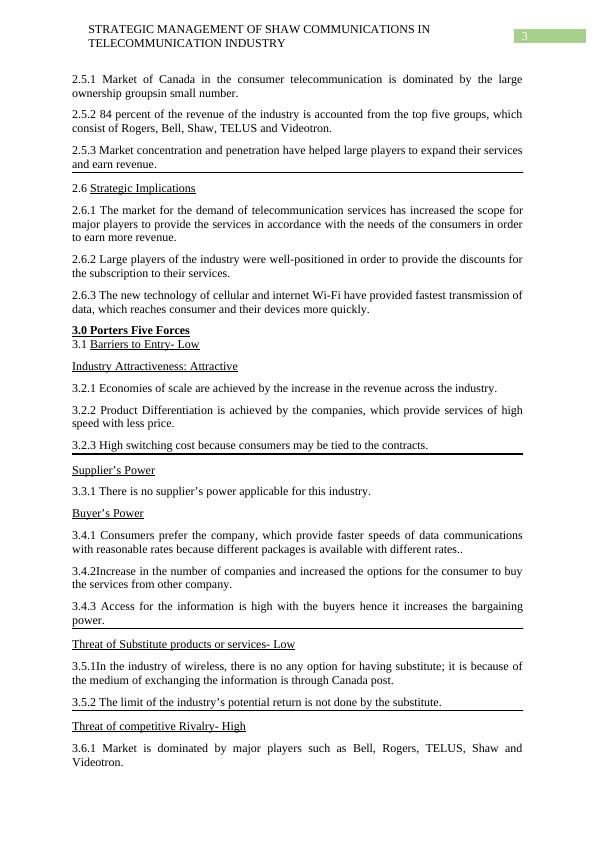Strategic Management of Shaw Communications in Telecommunication Industry
Added on 2023-01-17
16 Pages6405 Words97 Views
Running Head: STRATEGIC MANAGEMENT OF SHAW COMMUNICATIONS IN
TELECOMMUNICATION INDUSTRY
STRATEGIC MANAGEMENT OF SHAW COMMUNICATIONS IN
TELECOMMUNICATION INDUSTRY
Name of the Student
Name of the University
Author Note
TELECOMMUNICATION INDUSTRY
STRATEGIC MANAGEMENT OF SHAW COMMUNICATIONS IN
TELECOMMUNICATION INDUSTRY
Name of the Student
Name of the University
Author Note

1
STRATEGIC MANAGEMENT OF SHAW COMMUNICATIONS IN
TELECOMMUNICATION INDUSTRY
Appendix
External Analysis
1.0 PESTEL
1.1 Political
1.1.1Institution of pick ‘n’ pay policy: Changes in the policy CTRC, which requires BDUs
for providing basic “skinny” package of the channels of television and allowing the
consumers for purchasing content of media based on channel-by-channel. This policy has
affected the revenue of BDUs.
1.1.2Owning connectivity and media content: There was the requirement by the Canadian
Radio-television Telecommunication Commission for the companies of telecommunications,
which held the media assets for providing equal access to their content of their own media
from all the other providers of telecommunications.
___________________________________________________________________________
1.2 Economical
1.2.1 Market concentration- It has played important role in the services of the connectivity for
rising the bundling. The impact of this has increased the bundled services from the subscriber
of 8.8 million to 10.4 million.
1.2.2Market penetration: Canadian market penetration of wireless connectivity was 82
percent approximately of the total population and it was expected that it would grow to 1.4
annually. The average Canadian household has spent $203 per month on the
telecommunication services. The change was due to increased spending of wireless and
internet thatwas grown to 14% from 10%.
___________________________________________________________________________
1.3Social
1.3Shift in demand: Changes in the spending on the Internet services and wireless has grown
by 14.1 per cent, which are driven by the demand for the bandwidth for delivering the
services of data-intensive such as video streaming, game playing, photo sharing and web
browsing.
___________________________________________________________________________
1.4 Technological
1.4.1Flexibility in Media: Advancement of the technology has enabled the consumers for
viewing their choice of content when and wherever they wanted to see.Every year subscriber
of technological services is increasing.
1.4.2Access to Mobiles and tablets: With the help of cellular network connectivity and Wi-Fi
has enabled the viewers for watching the video through mobile phones and tablets.
___________________________________________________________________________
1.5Legal
1.5.1Legal implication on the industry: As of now, there is no such legal actions have been
taken by the country’s judiciary system. However, companies need to plan their strategy in
STRATEGIC MANAGEMENT OF SHAW COMMUNICATIONS IN
TELECOMMUNICATION INDUSTRY
Appendix
External Analysis
1.0 PESTEL
1.1 Political
1.1.1Institution of pick ‘n’ pay policy: Changes in the policy CTRC, which requires BDUs
for providing basic “skinny” package of the channels of television and allowing the
consumers for purchasing content of media based on channel-by-channel. This policy has
affected the revenue of BDUs.
1.1.2Owning connectivity and media content: There was the requirement by the Canadian
Radio-television Telecommunication Commission for the companies of telecommunications,
which held the media assets for providing equal access to their content of their own media
from all the other providers of telecommunications.
___________________________________________________________________________
1.2 Economical
1.2.1 Market concentration- It has played important role in the services of the connectivity for
rising the bundling. The impact of this has increased the bundled services from the subscriber
of 8.8 million to 10.4 million.
1.2.2Market penetration: Canadian market penetration of wireless connectivity was 82
percent approximately of the total population and it was expected that it would grow to 1.4
annually. The average Canadian household has spent $203 per month on the
telecommunication services. The change was due to increased spending of wireless and
internet thatwas grown to 14% from 10%.
___________________________________________________________________________
1.3Social
1.3Shift in demand: Changes in the spending on the Internet services and wireless has grown
by 14.1 per cent, which are driven by the demand for the bandwidth for delivering the
services of data-intensive such as video streaming, game playing, photo sharing and web
browsing.
___________________________________________________________________________
1.4 Technological
1.4.1Flexibility in Media: Advancement of the technology has enabled the consumers for
viewing their choice of content when and wherever they wanted to see.Every year subscriber
of technological services is increasing.
1.4.2Access to Mobiles and tablets: With the help of cellular network connectivity and Wi-Fi
has enabled the viewers for watching the video through mobile phones and tablets.
___________________________________________________________________________
1.5Legal
1.5.1Legal implication on the industry: As of now, there is no such legal actions have been
taken by the country’s judiciary system. However, companies need to plan their strategy in

2
STRATEGIC MANAGEMENT OF SHAW COMMUNICATIONS IN
TELECOMMUNICATION INDUSTRY
such a manner that, any legal changes by the judiciary of the country in this sector will have
minimum impact on the companies operating in this industry.
___________________________________________________________________________
1.6 Environmental
1.6.1Climatic Condition: There may be the impact of climate change in the network issues
and connectivity. Hence, companies need to be prepared for the same.
___________________________________________________________________________
1.7 Strategic Implications
1.7.1 The increase in the average spending of the Canadian household of $11.92 per month
has enhanced the telecommunication sector for investing in the wireless and internet services.
1.7.2 Changes in the preferences of the consumer have resulted have increased the demand.
Technology advancement by the industry has enabled to consumers to see the content they
want, anytime and anywhere.
1.7.3 Discounts given to the consumers for subscription to their connectivity services have
increased the revenue of the companies.
1.7.4 Launching of the OTT services such as Netflix and the platform of connectivity such as
Apple TV and Chrome cast have attracted the viewers of cable TV.
2.0 Dominant economic Feature Analysis
2.1 Market Size & Growth
2.1.1 Increase in the spending of $203 per month on telecommunication services has
increased to 6.2 per cent which $11.92 per month.
2.1.2There has been increase in the expenditure on the wireless as well as Internet services
from 10.0 percent to 14.1 percent.
2.2 Buyer Requirement & Needs
2.2.1 The Canadian market penetration of wireless, which was 82 per cent of the total
population, is expected to rise annually 1.4 per cent.
2.2.1 The total number of the subscriptions of the connectivity services has been increased
from 8.8 million to 10.4 million.
2.3 Technology & R&D
2.3.1The advancement of the technology has increased the use of tablets and mobile phones
with cellular network connectivity as well as Wi-Fi connections.
2.3.2 The policy of pick ‘n’ pick policy by CTRC has increased the revenue of the BDUs,
which passes through the channels of the media specialty.
2.4 Economies of Scales
2.4.1 With the help of increase in the revenue from the consumption of cellular data, there is
greater access to the public Wi-Fi, which has moderated the growth of the revenue.
2.5 Scope of Competitive Rivalry
STRATEGIC MANAGEMENT OF SHAW COMMUNICATIONS IN
TELECOMMUNICATION INDUSTRY
such a manner that, any legal changes by the judiciary of the country in this sector will have
minimum impact on the companies operating in this industry.
___________________________________________________________________________
1.6 Environmental
1.6.1Climatic Condition: There may be the impact of climate change in the network issues
and connectivity. Hence, companies need to be prepared for the same.
___________________________________________________________________________
1.7 Strategic Implications
1.7.1 The increase in the average spending of the Canadian household of $11.92 per month
has enhanced the telecommunication sector for investing in the wireless and internet services.
1.7.2 Changes in the preferences of the consumer have resulted have increased the demand.
Technology advancement by the industry has enabled to consumers to see the content they
want, anytime and anywhere.
1.7.3 Discounts given to the consumers for subscription to their connectivity services have
increased the revenue of the companies.
1.7.4 Launching of the OTT services such as Netflix and the platform of connectivity such as
Apple TV and Chrome cast have attracted the viewers of cable TV.
2.0 Dominant economic Feature Analysis
2.1 Market Size & Growth
2.1.1 Increase in the spending of $203 per month on telecommunication services has
increased to 6.2 per cent which $11.92 per month.
2.1.2There has been increase in the expenditure on the wireless as well as Internet services
from 10.0 percent to 14.1 percent.
2.2 Buyer Requirement & Needs
2.2.1 The Canadian market penetration of wireless, which was 82 per cent of the total
population, is expected to rise annually 1.4 per cent.
2.2.1 The total number of the subscriptions of the connectivity services has been increased
from 8.8 million to 10.4 million.
2.3 Technology & R&D
2.3.1The advancement of the technology has increased the use of tablets and mobile phones
with cellular network connectivity as well as Wi-Fi connections.
2.3.2 The policy of pick ‘n’ pick policy by CTRC has increased the revenue of the BDUs,
which passes through the channels of the media specialty.
2.4 Economies of Scales
2.4.1 With the help of increase in the revenue from the consumption of cellular data, there is
greater access to the public Wi-Fi, which has moderated the growth of the revenue.
2.5 Scope of Competitive Rivalry

3
STRATEGIC MANAGEMENT OF SHAW COMMUNICATIONS IN
TELECOMMUNICATION INDUSTRY
2.5.1 Market of Canada in the consumer telecommunication is dominated by the large
ownership groupsin small number.
2.5.2 84 percent of the revenue of the industry is accounted from the top five groups, which
consist of Rogers, Bell, Shaw, TELUS and Videotron.
2.5.3 Market concentration and penetration have helped large players to expand their services
and earn revenue.
2.6 Strategic Implications
2.6.1 The market for the demand of telecommunication services has increased the scope for
major players to provide the services in accordance with the needs of the consumers in order
to earn more revenue.
2.6.2 Large players of the industry were well-positioned in order to provide the discounts for
the subscription to their services.
2.6.3 The new technology of cellular and internet Wi-Fi have provided fastest transmission of
data, which reaches consumer and their devices more quickly.
3.0 Porters Five Forces
3.1 Barriers to Entry- Low
Industry Attractiveness: Attractive
3.2.1 Economies of scale are achieved by the increase in the revenue across the industry.
3.2.2 Product Differentiation is achieved by the companies, which provide services of high
speed with less price.
3.2.3 High switching cost because consumers may be tied to the contracts.
Supplier’s Power
3.3.1 There is no supplier’s power applicable for this industry.
Buyer’s Power
3.4.1 Consumers prefer the company, which provide faster speeds of data communications
with reasonable rates because different packages is available with different rates..
3.4.2Increase in the number of companies and increased the options for the consumer to buy
the services from other company.
3.4.3 Access for the information is high with the buyers hence it increases the bargaining
power.
Threat of Substitute products or services- Low
3.5.1In the industry of wireless, there is no any option for having substitute; it is because of
the medium of exchanging the information is through Canada post.
3.5.2 The limit of the industry’s potential return is not done by the substitute.
Threat of competitive Rivalry- High
3.6.1 Market is dominated by major players such as Bell, Rogers, TELUS, Shaw and
Videotron.
STRATEGIC MANAGEMENT OF SHAW COMMUNICATIONS IN
TELECOMMUNICATION INDUSTRY
2.5.1 Market of Canada in the consumer telecommunication is dominated by the large
ownership groupsin small number.
2.5.2 84 percent of the revenue of the industry is accounted from the top five groups, which
consist of Rogers, Bell, Shaw, TELUS and Videotron.
2.5.3 Market concentration and penetration have helped large players to expand their services
and earn revenue.
2.6 Strategic Implications
2.6.1 The market for the demand of telecommunication services has increased the scope for
major players to provide the services in accordance with the needs of the consumers in order
to earn more revenue.
2.6.2 Large players of the industry were well-positioned in order to provide the discounts for
the subscription to their services.
2.6.3 The new technology of cellular and internet Wi-Fi have provided fastest transmission of
data, which reaches consumer and their devices more quickly.
3.0 Porters Five Forces
3.1 Barriers to Entry- Low
Industry Attractiveness: Attractive
3.2.1 Economies of scale are achieved by the increase in the revenue across the industry.
3.2.2 Product Differentiation is achieved by the companies, which provide services of high
speed with less price.
3.2.3 High switching cost because consumers may be tied to the contracts.
Supplier’s Power
3.3.1 There is no supplier’s power applicable for this industry.
Buyer’s Power
3.4.1 Consumers prefer the company, which provide faster speeds of data communications
with reasonable rates because different packages is available with different rates..
3.4.2Increase in the number of companies and increased the options for the consumer to buy
the services from other company.
3.4.3 Access for the information is high with the buyers hence it increases the bargaining
power.
Threat of Substitute products or services- Low
3.5.1In the industry of wireless, there is no any option for having substitute; it is because of
the medium of exchanging the information is through Canada post.
3.5.2 The limit of the industry’s potential return is not done by the substitute.
Threat of competitive Rivalry- High
3.6.1 Market is dominated by major players such as Bell, Rogers, TELUS, Shaw and
Videotron.

End of preview
Want to access all the pages? Upload your documents or become a member.
Related Documents
Case Study Analysis and Reportlg...
|21
|7812
|46
Introduction of Rogers Wirelesslg...
|8
|2602
|298
Assignment on Trends and Development of E Commercelg...
|8
|2113
|119
Management and Operations Assignment : Virgin Mobilelg...
|4
|761
|70
Netflix: Business Model and Revenue Streamslg...
|6
|1746
|42
Economic Environment of Rogers Communications in Canadalg...
|10
|1300
|111